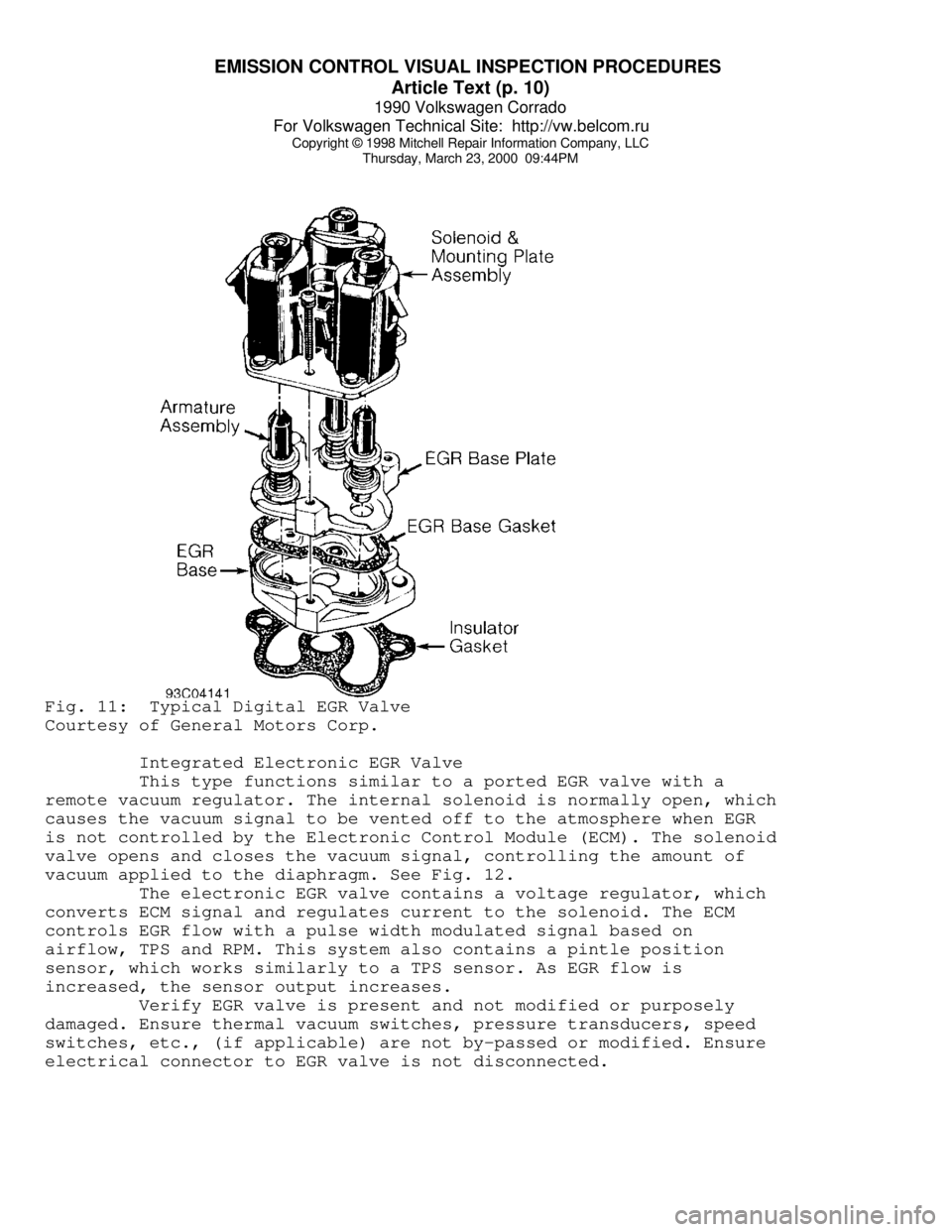1990 VOLKSWAGEN CORRADO sensor
[x] Cancel search: sensorPage 487 of 906

ELECTRICAL COMPONENT LOCATOR
Article Text (p. 28)
1990 Volkswagen Corrado
For Volkswagen Technical Site: http://vw.belcom.ru
Copyright © 1998 Mitchell Repair Information Company, LLC
Thursday, March 23, 2000 09:44PM
Fuel Gauge Sending Unit Mounted in top of fuel tank.
Hall Speed Sensor Rear of instrument cluster.
Heated Seat Temperature Sensor Below lower cushion of each
seat.Knock Sensor Mounted on cylinder block,
near dipstick.
Manifold Pressure Sensor In Digifant control unit,
below fresh air intake on
firewall.
Multi-Function Indicator
Vacuum Sensor Round sensor mounted on rear
of instrument cluster.
Oil Temperature Sending Unit Small sending unit above oil
filter (Green/Black wire
connector).
Oxygen Sensor In exhaust pipe, near
catalytic converter.
Vehicle Speed Sensor On transaxle.
Page 488 of 906

ELECTRICAL COMPONENT LOCATOR
Article Text (p. 29)
1990 Volkswagen Corrado
For Volkswagen Technical Site: http://vw.belcom.ru
Copyright © 1998 Mitchell Repair Information Company, LLC
Thursday, March 23, 2000 09:44PM
Wheel Speed Sensor Mounted near hub assembly.ÄÄÄÄÄÄÄÄÄÄÄÄÄÄÄÄÄÄÄÄÄÄÄÄÄÄÄÄÄÄÄÄÄÄÄÄÄÄÄÄÄÄÄÄÄÄÄÄÄÄÄÄÄÄÄÄÄÄÄÄÄÄÄÄÄÄÄÄÄÄ SOLENOIDS & SOLENOID VALVES
ÄÄÄÄÄÄÄÄÄÄÄÄÄÄÄÄÄÄÄÄÄÄÄÄÄÄÄÄÄÄÄÄÄÄÄÄÄÄÄÄÄÄÄÄÄÄÄÄÄÄÄÄÄÄÄÄÄÄÄÄÄÄÄÄÄÄÄÄÄÄComponent Component Location
ÄÄÄÄÄÄÄÄÄÄÄÄÄÄÄÄÄÄÄÄÄÄÄÄÄÄÄÄÄÄÄÄÄÄÄÄÄÄÄÄÄÄÄÄÄÄÄÄÄÄÄÄÄÄÄÄÄÄÄÄÄÄÄÄÄÄÄÄÄÄIdle Stabilizer Valve Across from throttle valve,
near valve cover.
ÄÄÄÄÄÄÄÄÄÄÄÄÄÄÄÄÄÄÄÄÄÄÄÄÄÄÄÄÄÄÄÄÄÄÄÄÄÄÄÄÄÄÄÄÄÄÄÄÄÄÄÄÄÄÄÄÄÄÄÄÄÄÄÄÄÄÄÄÄÄ SWITCHES
ÄÄÄÄÄÄÄÄÄÄÄÄÄÄÄÄÄÄÄÄÄÄÄÄÄÄÄÄÄÄÄÄÄÄÄÄÄÄÄÄÄÄÄÄÄÄÄÄÄÄÄÄÄÄÄÄÄÄÄÄÄÄÄÄÄÄÄÄÄÄComponent Component Location
ÄÄÄÄÄÄÄÄÄÄÄÄÄÄÄÄÄÄÄÄÄÄÄÄÄÄÄÄÄÄÄÄÄÄÄÄÄÄÄÄÄÄÄÄÄÄÄÄÄÄÄÄÄÄÄÄÄÄÄÄÄÄÄÄÄÄÄÄÄÄA/C Pressure Switch In refrigerant line, near left
side of condenser.
Anti-Lock Brake (ABS) Pressure
Warning Switch Mounted in hydraulic modulator
below brake fluid reservoir.
Back-Up Light Switch Mounted near gear selector on
transmission.
Brake Fluid Level Switch In cap on brake fluid
reservoir.
Page 503 of 906

EMISSION CONTROL VISUAL INSPECTION PROCEDURES
Article Text (p. 9)
1990 Volkswagen Corrado
For Volkswagen Technical Site: http://vw.belcom.ru
Copyright © 1998 Mitchell Repair Information Company, LLC
Thursday, March 23, 2000 09:44PMFig. 10: Typical Negative Backpressure EGR Valve
Courtesy of General Motors Corp.
Digital EGR Valve
The digital EGR valve operates independently of engine
manifold vacuum. This valve controls EGR flow through 3 orifices.
These 3 orifices are opened and closed by electric solenoids. The
solenoids are, in turn, controlled by the Electronic Control Module
(ECM). When a solenoid is energized, the armature with attached shaft
and swivel pintle is lifted, opening the orifice. See Fig. 11.
The ECM uses inputs from the Coolant Temperature Sensor
(CTS), Throttle Position Sensor (TPS) and Mass Airflow (MAF) sensors
to control the EGR orifices to make 7 different combinations for
precise EGR flow control. At idle, the EGR valve allows a very small
amount of exhaust gas to enter the intake manifold. This EGR valve
normally operates above idle speed during warm engine operation.
Verify EGR valve is present and not modified or purposely
damaged. Ensure thermal vacuum switches, pressure transducers, speed
switches, etc., (if applicable) are not by-passed or modified. Ensure
vacuum hose(s) to EGR valve is not plugged. Ensure electrical
connector to EGR valve is not disconnected.
Page 504 of 906

EMISSION CONTROL VISUAL INSPECTION PROCEDURES
Article Text (p. 10)
1990 Volkswagen Corrado
For Volkswagen Technical Site: http://vw.belcom.ru
Copyright © 1998 Mitchell Repair Information Company, LLC
Thursday, March 23, 2000 09:44PMFig. 11: Typical Digital EGR Valve
Courtesy of General Motors Corp.
Integrated Electronic EGR Valve
This type functions similar to a ported EGR valve with a
remote vacuum regulator. The internal solenoid is normally open, which
causes the vacuum signal to be vented off to the atmosphere when EGR
is not controlled by the Electronic Control Module (ECM). The solenoid
valve opens and closes the vacuum signal, controlling the amount of
vacuum applied to the diaphragm. See Fig. 12.
The electronic EGR valve contains a voltage regulator, which
converts ECM signal and regulates current to the solenoid. The ECM
controls EGR flow with a pulse width modulated signal based on
airflow, TPS and RPM. This system also contains a pintle position
sensor, which works similarly to a TPS sensor. As EGR flow is
increased, the sensor output increases.
Verify EGR valve is present and not modified or purposely
damaged. Ensure thermal vacuum switches, pressure transducers, speed
switches, etc., (if applicable) are not by-passed or modified. Ensure
electrical connector to EGR valve is not disconnected.
Page 505 of 906

EMISSION CONTROL VISUAL INSPECTION PROCEDURES
Article Text (p. 11)
1990 Volkswagen Corrado
For Volkswagen Technical Site: http://vw.belcom.ru
Copyright © 1998 Mitchell Repair Information Company, LLC
Thursday, March 23, 2000 09:44PMFig. 12: Cutaway View Of Typical Integrated Electronic EGR Valve
Courtesy of General Motors Corp.
SPARK CONTROLS (SPK)
Spark control systems are designed to ensure the air/fuel
mixture is ignited at the best possible moment to provide optimum
efficiency and power and cleaner emissions.
Ensure vacuum hoses to the distributor, carburetor, spark
delay valves, thermal vacuum switches, etc., are in place and routed
properly. On Computerized Engine Controls (CEC), check for presence of
required sensors (O2, MAP, CTS, TPS, etc.). Ensure they have not been
tampered with or modified.
Check for visible modification or replacement of the feedback
carburetor, fuel injection unit or injector(s) with a non-feedback
carburetor or fuel injection system. Check for modified emission-
related components unacceptable for use on pollution-controlled
vehicles.
AIR INJECTION SYSTEM (AIS)
Air Pump Injection System (AP)
The air pump is a belt-driven vane type pump, mounted to
engine in combination with other accessories. The air pump itself
Page 507 of 906

EMISSION CONTROL VISUAL INSPECTION PROCEDURES
Article Text (p. 13)
1990 Volkswagen Corrado
For Volkswagen Technical Site: http://vw.belcom.ru
Copyright © 1998 Mitchell Repair Information Company, LLC
Thursday, March 23, 2000 09:44PM
OXYGEN SENSOR (O2)
The O2 sensor is mounted in the exhaust system where it
monitors oxygen content of exhaust gases. Some vehicles may use 2 O2
sensors. The O2 sensor produces a voltage signal which is proportional
to exhaust gas oxygen concentration (0-3%) compared to outside oxygen
(20-21%). This voltage signal is low (about .1 volt) when a lean
mixture is present and high (1.0 volt) when a rich mixture is present.
As ECM compensates for a lean or rich condition, this
voltage signal constantly fluctuates between high and low, crossing a
reference voltage supplied by the ECM on the O2 signal line. This is
referred to as cross counts. A problem in the O2 sensor circuit should
set a related trouble code.
COMPUTERIZED ENGINE CONTROLS (CEC)
The CEC system monitors and controls a variety of
engine/vehicle functions. The CEC system is primarily an emission
control system designed to maintain a 14.7:1 air/fuel ratio under most
operating conditions. When the ideal air/fuel ratio is maintained, the
catalytic converter can control oxides of nitrogen (NOx), hydrocarbon
(HC) and carbon monoxide (CO) emissions.
The CEC system consists of the following sub-systems:
Electronic Control Module (ECM), input devices (sensors and switches)
and output signals.
EARLY FUEL EVAPORATION (EFE)
The EFE valve is actuated by either a vacuum actuator or a
bimetal spring (heat-riser type). The EFE valve is closed when engine
is cold. The closed valve restricts exhaust gas flow from the exhaust
manifold. This forces part of the exhaust gas to flow up through a
passage below the carburetor. As the exhaust gas quickly warms the
intake mixture, distribution is improved. This results in better cold
engine driveability, shorter choke periods and lower emissions.
Ensure EFE valve in exhaust manifold is not frozen or rusted
in a fixed position. On vacuum-actuated EFE system, check EFE thermal
vacuum valve and check valve(s). Also check for proper vacuum hose
routing. See Fig. 15.
Page 546 of 906

F - BASIC TESTING
Article Text
1990 Volkswagen Corrado
For Volkswagen Technical Site: http://vw.belcom.ru
Copyright © 1998 Mitchell Repair Information Company, LLC
Thursday, March 23, 2000 09:44PM
ARTICLE BEGINNING
1990 ENGINE PERFORMANCE
Volkswagen Basic Diagnostic Procedures
Cabriolet, Corrado, Fox, Golf GL/GTI, Jetta, Vanagon
INTRODUCTION
The following diagnostic steps will help prevent overlooking
a simple problem. This is also where to begin diagnosis for a no start
condition.
The first step in diagnosing any driveability problem is
verifying the customer's complaint with a test drive under the
conditions the problem reportedly occurred.
Perform a careful and complete visual inspection. Most engine
control problems result from mechanical breakdowns, poor electrical
connections or damaged/misrouted vacuum hoses. Before condemning the
computerized system, perform each test listed in this article.
NOTE: Perform all voltage tests with a Digital Volt-Ohmmeter
(DVOM) with a minimum 10-megohm input impedance, unless
stated otherwise in test procedure.
VISUAL INSPECTION
Visually inspect all electrical wiring, looking for chafed,
stretched, cut or pinched wiring. Ensure electrical connectors fit
tightly and are not corroded. Ensure vacuum hoses are properly routed
and are not pinched or cut. See M - VACUUM DIAGRAMS article to verify
routing and connections (if necessary). Inspect air induction system
for possible vacuum leaks.
MECHANICAL INSPECTION
COMPRESSION
Check engine mechanical condition with a compression gauge,
vacuum gauge, or an engine analyzer. See engine analyzer manual for
specific instructions.
DO NOT use ignition switch during compression tests on fuel
injected vehicles. Use a remote starter to crank engine. Fuel
injectors on many models are triggered by ignition switch during
cranking mode, which can create a fire hazard or contaminate the
engine's oiling system.
EXHAUST SYSTEM BACKPRESSURE
The exhaust system can be checked with a vacuum or pressure
gauge. Remove O2 sensor or air injection check valve (if equipped).
Connect a 1-10 psi pressure gauge and run engine at 2500 RPM. If
Page 547 of 906

F - BASIC TESTING
Article Text (p. 2)
1990 Volkswagen Corrado
For Volkswagen Technical Site: http://vw.belcom.ru
Copyright © 1998 Mitchell Repair Information Company, LLC
Thursday, March 23, 2000 09:44PM
exhaust system backpressure is greater than 1 3/4-2 psi, exhaust
system or catalytic converter is plugged.
If a vacuum gauge is used, connect vacuum gauge hose to
intake manifold vacuum port and start engine. Observe vacuum gauge.
Open throttle part way and hold steady. If vacuum gauge reading slowly
drops after stabilizing, exhaust system should be checked for a
restriction.
FUEL SYSTEM APPLICATION TABLE
FUEL SYSTEM APPLICATION TABLEÄÄÄÄÄÄÄÄÄÄÄÄÄÄÄÄÄÄÄÄÄÄÄÄÄÄÄÄÄÄÄÄÄÄÄÄÄÄÄÄÄÄÄÄÄÄÄÄÄÄÄÄÄÄÄÄÄÄÄÄApplication Fuel System
Cabriolet, Corrado, Golf GL/GTI
Jetta & Vanagon ........................ AFC-Digifant II
Fox ................................................ CIS-E
Jetta GLi ................................... CIS-Motronic
ÄÄÄÄÄÄÄÄÄÄÄÄÄÄÄÄÄÄÄÄÄÄÄÄÄÄÄÄÄÄÄÄÄÄÄÄÄÄÄÄÄÄÄÄÄÄÄÄÄÄÄÄÄÄÄÄÄÄÄÄ FUEL PRESSURE CHECK
Basic diagnosis of fuel system should begin with determining
fuel system pressure.
FUEL PUMP CIRCUIT CHECK
Remove fuel tank cap. Turn ignition on and listen for fuel
pump operating sound for approximately 2 seconds. If there is no
sound, check fuse, fuel pump relay, fuel pump and all electrical
connections.
VISUAL CHECK (AFC-DIGIFANT II)
Push air door open, slight resistance should be felt and door
should not bind. Uniform resistance should be felt throughout travel
after slight amount of free travel. No binding should be felt when air
door is released.
VISUAL CHECK (CIS-E & CIS-MOTRONIC)
Move sensor plate slowly upward. Sensor plate should have
slight resistance from control piston adjusting lever. No binding
should be felt. Let sensor plate fall. There should no resistance.
Slight fuel seepage past control piston is acceptable.
FUEL PRESSURE TEST
WARNING: ALWAYS relieve fuel pressure before disconnecting any fuel
injection-related component. DO NOT allow fuel to contact
engine or electrical components.